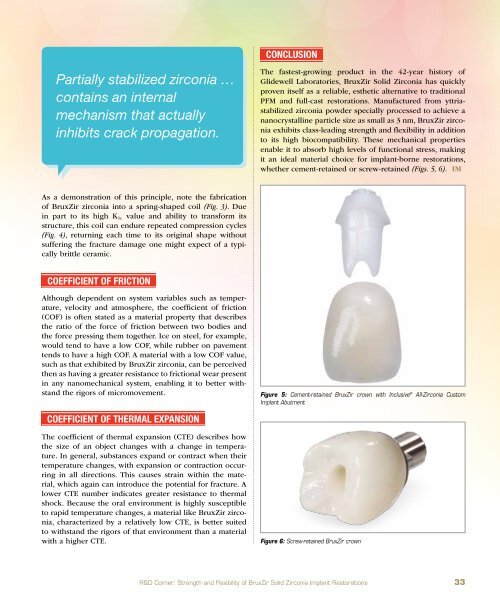PDF Download - Glidewell Dental Labs
PDF Download - Glidewell Dental Labs
PDF Download - Glidewell Dental Labs
Create successful ePaper yourself
Turn your PDF publications into a flip-book with our unique Google optimized e-Paper software.
CONCLUSION<br />
Partially stabilized zirconia …<br />
contains an internal<br />
mechanism that actually<br />
inhibits crack propagation.<br />
The fastest-growing product in the 42-year history of<br />
<strong>Glidewell</strong> Laboratories, BruxZir Solid Zirconia has quickly<br />
proven itself as a reliable, esthetic alternative to traditional<br />
PFM and full-cast restorations. Manufactured from yttriastabilized<br />
zirconia powder specially processed to achieve a<br />
nanocrystalline particle size as small as 3 nm, BruxZir zirconia<br />
exhibits class-leading strength and flexibility in addition<br />
to its high biocompatibility. These mechanical properties<br />
enable it to absorb high levels of functional stress, making<br />
it an ideal material choice for implant-borne restorations,<br />
whether cement-retained or screw-retained (Figs. 5, 6). IM<br />
As a demonstration of this principle, note the fabrication<br />
of BruxZir zirconia into a spring-shaped coil (Fig. 3). Due<br />
in part to its high K 1c value and ability to transform its<br />
structure, this coil can endure repeated compression cycles<br />
(Fig. 4), returning each time to its original shape without<br />
suffering the fracture damage one might expect of a typically<br />
brittle ceramic.<br />
COEFFICIENT OF FRICTION<br />
Although dependent on system variables such as temperature,<br />
velocity and atmosphere, the coefficient of friction<br />
(COF) is often stated as a material property that describes<br />
the ratio of the force of friction between two bodies and<br />
the force pressing them together. Ice on steel, for example,<br />
would tend to have a low COF, while rubber on pavement<br />
tends to have a high COF. A material with a low COF value,<br />
such as that exhibited by BruxZir zirconia, can be perceived<br />
then as having a greater resistance to frictional wear present<br />
in any nanomechanical system, enabling it to better withstand<br />
the rigors of micromovement.<br />
Figure 5: Cement-retained BruxZir crown with Inclusive ® All-Zirconia Custom<br />
Implant Abutment<br />
COEFFICIENT OF THERMAL EXPANSION<br />
The coefficient of thermal expansion (CTE) describes how<br />
the size of an object changes with a change in temperature.<br />
In general, substances expand or contract when their<br />
temperature changes, with expansion or contraction occurring<br />
in all directions. This causes strain within the material,<br />
which again can introduce the potential for fracture. A<br />
lower CTE number indicates greater resistance to thermal<br />
shock. Because the oral environment is highly susceptible<br />
to rapid temperature changes, a material like BruxZir zirconia,<br />
characterized by a relatively low CTE, is better suited<br />
to withstand the rigors of that environment than a material<br />
with a higher CTE.<br />
Figure 6: Screw-retained BruxZir crown<br />
R&D Corner: Strength and Flexibility of BruxZir Solid Zirconia Implant Restorations 33

















